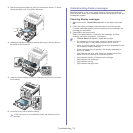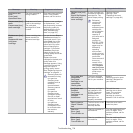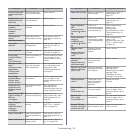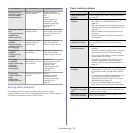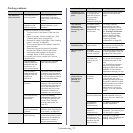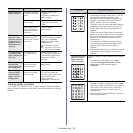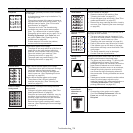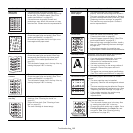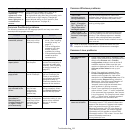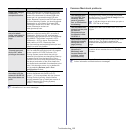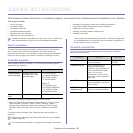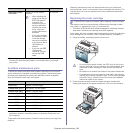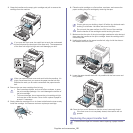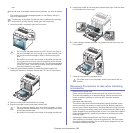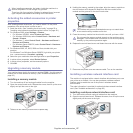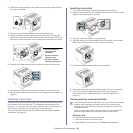
Troubleshooting_ 81
Common PostScript problems
The following situations are PS language specific and may occur when
several printer languages are used.
Common Windows problems
Refer to Microsoft Windows User’s Guide that came with your
computer for further information on Windows error messages.
Common Linux problems
An unknown image
repetitively
appears on a few
sheets or loose
toner, light print, or
contamination
occurs.
Your machine is probably being used at an
altitude of 1,000 m (3,281 ft) or above.
The high altitude may affect the print quality, such
as loose toner or light imaging. Change the
correct altitude setting to your machine. (See
"Altitude adjustment" on page 40.)
Problem Possible cause Solution
PostScript file
cannot be printed.
The PostScript
driver may not be
installed correctly.
• Install the PostScript
driver. (See "Installing
the driver locally" on
page 23.)
• Print a configuration
page and verify that
the PS version is
available for printing.
• If the problem persists,
contact a service
representative.
“Limit Check Error”
report prints.
The print job was
too complex.
You might need to
reduce the complexity of
the page or install more
memory. (See "Installing
a memory module" on
page 87.)
A PostScript error
page prints.
The print job may
not be PostScript.
Make sure that the print
job is a PostScript job.
Check to see whether
the software application
expected a setup or
PostScript header file to
be sent to the machine.
The optional tray is
not selected in the
driver.
The printer driver
has not been
configured to
recognize the
optional tray.
Open the PostScript
driver properties, select
the Device Options tab,
and set the tray option.
When printing a
document in
Macintosh with
Acrobat Reader 6.0
or higher, colors
print incorrectly.
The resolution
setting in the printer
driver may not be
matched with the
one in Acrobat
Reader.
Make sure that the
resolution setting in your
printer driver matches
the one in Acrobat
Reader.
Condition Suggested Solutions
Condition Suggested solutions
“File in Use”
message appears
during installation.
Exit all software applications. Remove all
software from the printer’s startup group, then
restart Windows. Reinstall the printer driver.
“General Protection
Fault”, “Exception
OE”, “Spool 32”, or
“Illegal Operation”
messages appear.
Close all other applications, reboot Windows
and try printing again.
“Fail To Print”, “A
printer timeout error
occurred” messages
appear.
These messages may appear during printing.
Just keep waiting until the machine finishes
printing. If the message appears in standby
mode or after printing has been completed,
check the connection and/or whether an error
has occurred.
condition Suggested solutions
The machine does
not print.
• Check if the printer driver is installed in your
system. Open Unified Driver Configurator and
switch to the Printers tab in Printers
configuration window to look at the list of
available machines. Make sure that your
machine is displayed on the list. If not, open
Add new printer wizard to set up your
device.
• Check if the machine is started. Open
Printers configuration and select your
machine on the printers list. Look at the
description in the Selected printer pane. If its
status contains Stopped string, press the
Start button. After that normal operation of
the machine should be restored. The
“stopped” status might be activated when
some problems in printing occurred.
• Check if your application has special print
option such as “-oraw”. If “-oraw” is specified
in the command line parameter, then remove
it to print properly. For Gimp front-end, select
“print” -> “Setup printer” and edit command
line parameter in the command item.
Some color images
come out all black.
This is a known bug in Ghostscript (until GNU
Ghostscript version 7.05) when the base color
space of the document is indexed color space
and is converted through CIE color space.
Because Postscript uses CIE color space for
Color Matching System, you should upgrade
Ghostscript on your system to at least GNU
Ghostscript version 7.06 or later. You can find
recent Ghostscript versions at
www.ghostscript.com.



